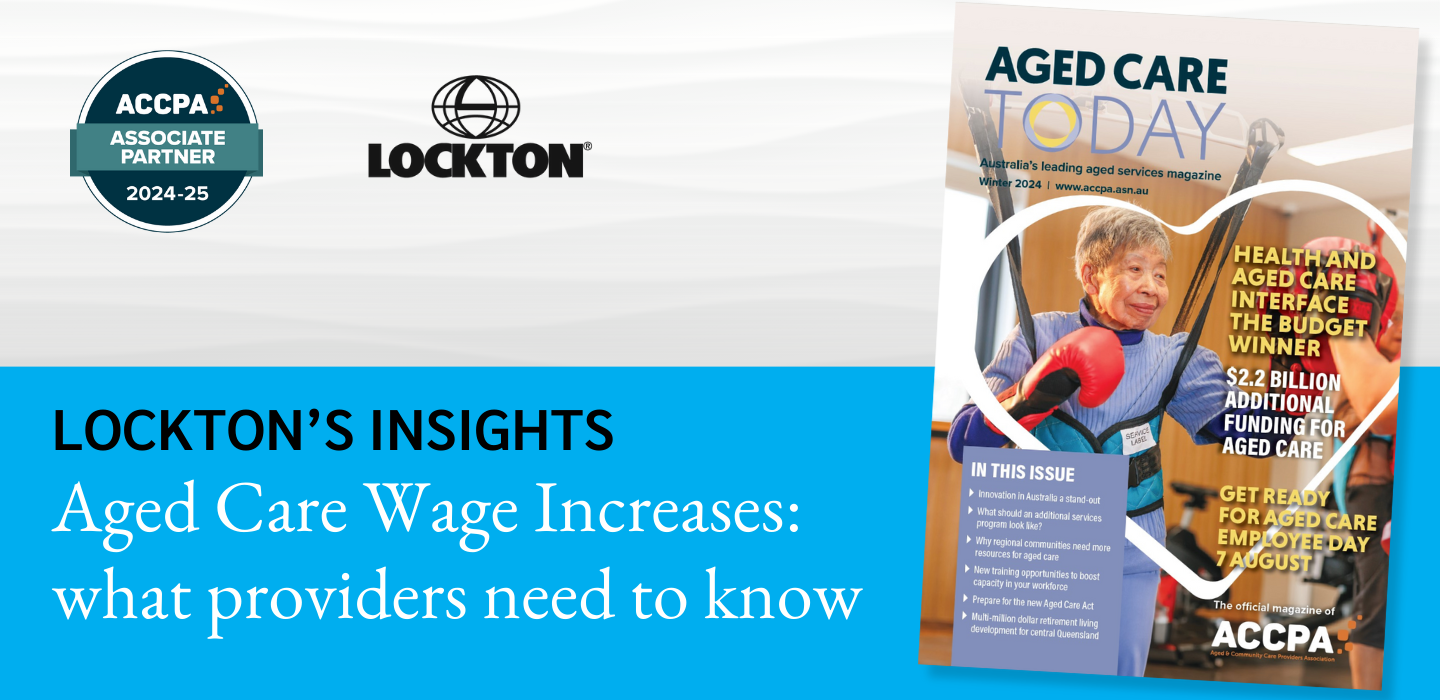
As published in the Winter 2024 issue of Aged Care Today (opens a new window) – the quarterly magazine of Aged & Community Care Providers Association (opens a new window) (ACCPA).
The decision by the Fair Work Commission (FWC) to grant significant wage increases to aged care workers could potentially be a defining moment for the sector struggling with ongoing workforce challenges.
Benefiting over 200,000 workers, the decision holds promise to address many of the significant workforce issues, notably the capacity to attract and retain a more highly skilled workforce.
However, alongside the potential benefits, the wage increases are poised to introduce a complex mix of potential risk and insurance implications for aged care providers.
Workers’ compensation
The immediate aftermath of the wage increases on workers’ compensation insurance is likely to be a challenging scenario for many providers.
'Total wages' is a key component in calculating workers’ compensation premiums, alongside ‘industry rate’ and an employer’s claims performance.
Industry rates for the aged care sector have also increased significantly in recent years, especially in the eastern states.
For many providers, the combination of higher total wages and industry rates will mean significant increases in workers’ compensation premiums.
Higher wages will also increase the costs of existing claims with a time loss component, which is expected to further exacerbate the pressure on premiums.
While the short-term outlook for workers’ compensation may be challenging, the longer-term outlook is potentially more positive.
A more skilled and experienced workforce holds the potential for aged care providers to improve work health and safety (WHS) outcomes, thereby reducing workers’ compensation costs over time.
Additionally, higher wages may also bring about a collective improvement in WHS outcomes across the entire aged care sector, which may positively impact industry rates.
This confluence of factors underscores the need for providers to review their current workers compensation insurance coverage.
Alternative pricing structures and premium funding are potential options that may offer ways for providers to navigate the short-term challenges posed by the wage increases.
Public liability
The potential impact on public liability risk is likely to be positive.
With a more skilled and experienced workforce, providers may be able to strategically prioritise safety, quality and regulatory compliance while implementing training and innovation efforts to adopt new and enhanced care methodologies.
Such measures have the potential to decrease the occurrence of incidents and the resulting claims pertaining to abuse, negligence or lapses in the quality of care.
As a result, providers may experience a decrease in liability risk which may translate to more favourable insurance outcomes.
Medical malpractice and professional indemnity
The anticipated impact on medical malpractice and professional indemnity insurance may also result in positive outcomes.
The qualifications, experience and training of healthcare professionals directly influence the clinical risk of errors or malpractice incidents.
The potential reduction in such incidents due to a more skilled and experienced workforce could lead to a decrease in medical malpractice and professional indemnity risk, which could result in more cost effective and broader coverage available to providers.
Employment practices liability
The impact of higher wages on Employment Practices Liability (EPL) is likely to be mixed.
On one hand, higher wages typically lead to higher levels of employee satisfaction, which can decrease the likelihood of claims against management for discrimination, unfair dismissal or similar issues.
A potential decrease in EPL claims frequency has the potential to positively influence insurance outcomes.
However, the flip side is the potential for increased settlement amounts for claims or judgments in employment-related lawsuits, necessitating higher coverage limits which would inevitably lead to increased premiums.
Providers should assess their EPL insurance policies to ensure they are adequately covered for the increased cumulative risks and make any necessary adjustments to coverage limits.
Management liability, directors and officers liability, and statutory liability
Finally, there is potentially positive news regarding governance risk.
A more skilled and experienced workforce has the potential to empower the 'Responsible Persons' of aged care providers to fulfill their governance obligations more effectively.
Possible improvements in regulatory compliance and the capacity to exceed mandated care standards could potentially result in decreased governance risk.
However, this potential reduction in governance risk coincides with significant impending changes to aged care legislation, which are likely to further complicate the aged care governance risk landscape.
Looking forward
Given the potentially wide-ranging risk and insurance implications of the wage increases, aged care providers are advised to review their current risk management strategies and insurance policies to ensure they are well prepared to address the impacts.
The contents of this publication are provided for general information only. Lockton arranges the insurance and is not the insurer. While the content contributors have taken reasonable care in compiling the information presented, we do not warrant that the information is correct. It is not intended to be interpreted as advice on which you should rely and may not necessarily be suitable for you. You must obtain professional or specialist advice before taking, or refraining from, any action on the basis of the content in this publication.

